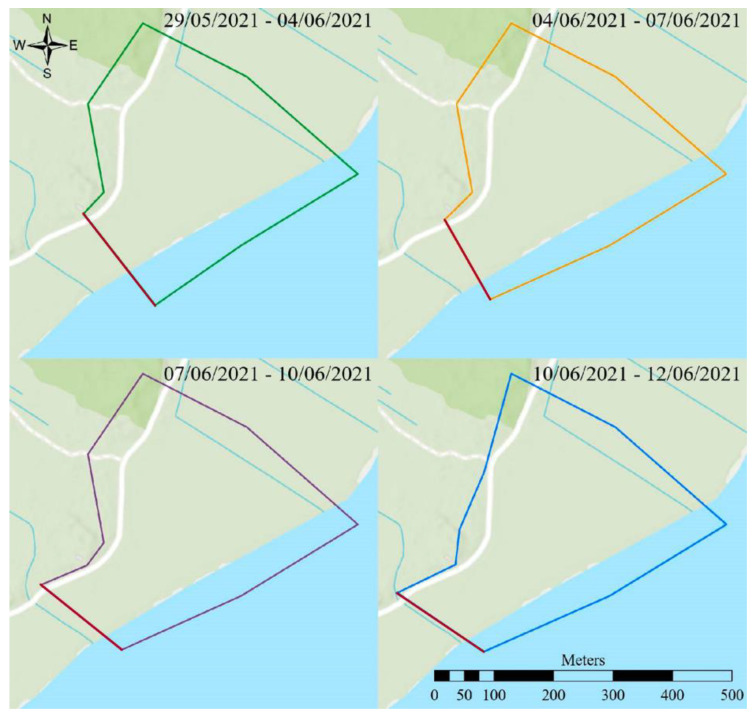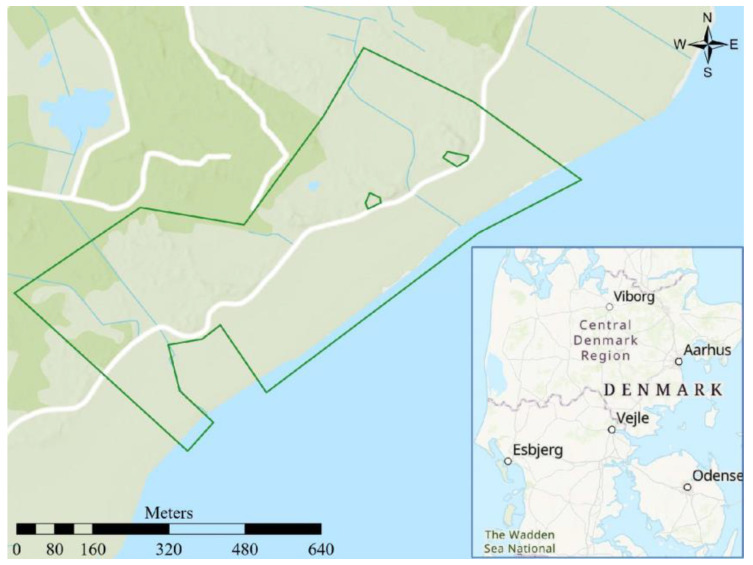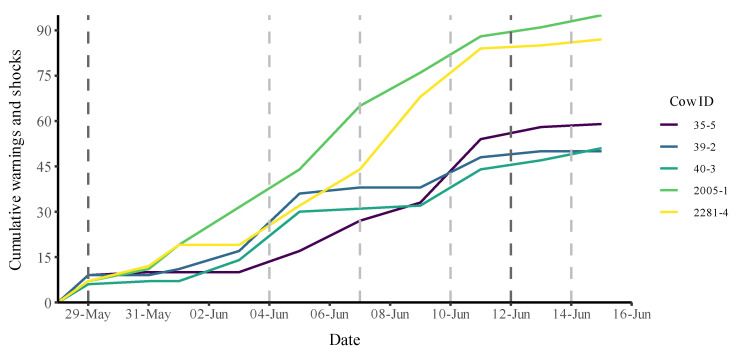Christian Sonne, Aage Kristian Olsen Alstrup, Cino Pertoldi, John Frikke, Anne Cathrine Linder, Bjarne Styrishave
{"title":"Cortisol in Manure from Cattle Enclosed with Nofence Virtual Fencing.","authors":"Christian Sonne, Aage Kristian Olsen Alstrup, Cino Pertoldi, John Frikke, Anne Cathrine Linder, Bjarne Styrishave","doi":"10.3390/ani12213017","DOIUrl":null,"url":null,"abstract":"<p><p>To increase the efficiency and geographic expansion of nature conservation, large grazers have recently been used, either in the form of wild hoof-bearing animals or as domesticated ruminants including cattle. Using physical fencing limits migrating wildlife, while virtual fences encourage the animals to stay in the desired area without physical restrictions on wild animals. However, virtual fences raise ethical questions regarding the electric impulses emitted by the collar and stress in the fenced animals. Here, we tested if keeping twelve Angus cows (<i>Bos Taurus</i>) in a virtual fencing (Nofence©) compromised their welfare. For this purpose, we collected manure samples from five cows every second day prior to and after the transition from traditional to virtual fencing over a period of 18 days. Cortisol concentrations were 20.6 ± 5.23 ng/g <i>w</i>/<i>w</i> (mean ± SD), ranging from 12 to 42 ng/g <i>w</i>/<i>w</i> across individuals and concentrations did not change over the study period. We, therefore, conclude that there is no evidence suggesting that the cows were stressed from the use for virtual fencing, thus making virtual fencing a reasonable alternative to traditional electric physical fencing of cows.</p>","PeriodicalId":519482,"journal":{"name":"Animals : an Open Access Journal from MDPI","volume":" ","pages":""},"PeriodicalIF":0.0000,"publicationDate":"2022-11-03","publicationTypes":"Journal Article","fieldsOfStudy":null,"isOpenAccess":false,"openAccessPdf":"https://www.ncbi.nlm.nih.gov/pmc/articles/PMC9656181/pdf/","citationCount":"4","resultStr":null,"platform":"Semanticscholar","paperid":null,"PeriodicalName":"Animals : an Open Access Journal from MDPI","FirstCategoryId":"97","ListUrlMain":"https://doi.org/10.3390/ani12213017","RegionNum":0,"RegionCategory":null,"ArticlePicture":[],"TitleCN":null,"AbstractTextCN":null,"PMCID":null,"EPubDate":"","PubModel":"","JCR":"","JCRName":"","Score":null,"Total":0}
引用次数: 4
Abstract
To increase the efficiency and geographic expansion of nature conservation, large grazers have recently been used, either in the form of wild hoof-bearing animals or as domesticated ruminants including cattle. Using physical fencing limits migrating wildlife, while virtual fences encourage the animals to stay in the desired area without physical restrictions on wild animals. However, virtual fences raise ethical questions regarding the electric impulses emitted by the collar and stress in the fenced animals. Here, we tested if keeping twelve Angus cows (Bos Taurus) in a virtual fencing (Nofence©) compromised their welfare. For this purpose, we collected manure samples from five cows every second day prior to and after the transition from traditional to virtual fencing over a period of 18 days. Cortisol concentrations were 20.6 ± 5.23 ng/g w/w (mean ± SD), ranging from 12 to 42 ng/g w/w across individuals and concentrations did not change over the study period. We, therefore, conclude that there is no evidence suggesting that the cows were stressed from the use for virtual fencing, thus making virtual fencing a reasonable alternative to traditional electric physical fencing of cows.



Nofence虚拟围栏封闭牛粪中的皮质醇含量。
为了提高自然保护的效率和扩大自然保护的地理范围,最近开始使用大型食草动物,要么是有蹄的野生动物,要么是驯养的反刍动物,包括牛。使用物理围栏限制了野生动物的迁徙,而虚拟围栏鼓励动物留在理想的区域,而没有对野生动物的物理限制。然而,虚拟围栏引发了关于项圈发出的电脉冲和围栏动物的压力的伦理问题。在这里,我们测试了在虚拟围栏(Nofence©)中饲养12头安格斯奶牛(Bos Taurus)是否会损害它们的福利。为此,我们在18天的时间里,在从传统围栏过渡到虚拟围栏之前和之后,每隔一天收集5头奶牛的粪便样本。皮质醇浓度为20.6±5.23 ng/g w/w (mean±SD),在个体之间的范围为12至42 ng/g w/w,并且在研究期间浓度没有变化。因此,我们得出结论,没有证据表明虚拟围栏的使用对奶牛造成了压力,因此虚拟围栏是传统电动物理围栏的合理替代方案。
本文章由计算机程序翻译,如有差异,请以英文原文为准。




 求助内容:
求助内容: 应助结果提醒方式:
应助结果提醒方式:


